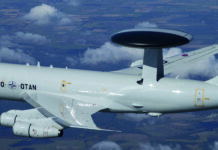In response to a request for information (RFI) from the NATO Support and Procurement Agency (NSPA), Sweden’s Saab has offered its GlobalEye airborne early warning and control (AEW&C) platform as a successor to the E-3 Airborne Warning and Control System (AWACS), the company announced on 21 February 2023.
In the Alliance Future Surveillance and Control (AFSC) project, launched in 2017, NATO is defining its early warning surveillance and control capabilities. The aim is to procure a successor system that can replace the current E-3 AWACS platforms from 2035. On behalf of NATO, NSPA has been conducting a concept phase since 2017 and in April 2020 commissioned three industry consortia to conduct risk mitigation and feasibility studies.
Saab describes GlobalEye as a multi-domain AEW&C solution with a range of active and passive sensors that provide long-range detection and identification of objects in the air, at sea and over land. By providing real-time information to air force, army and navy units, GlobalEye enables improved situational awareness of the environment and early detection of threats, the company said.

The GlobalEye platform, which is based on the Bombardier Global 6000 business jet, can also be used for non-military tasks such as directing and co-ordinating rescue operations during natural disasters or major accidents at sea or on land.
Saab delivered the first of three GlobalEyes to the United Arab Emirates (UAE) in 2020. Its orderbook includes two more aircraft for the UAE due for delivery in 2025 and two (with an option for two more) for Sweden, with deliveries running until 2027.
In addition, GlobalEye is under discussion in Greece to replace the Erieye system there.
Gerhard Heiming






